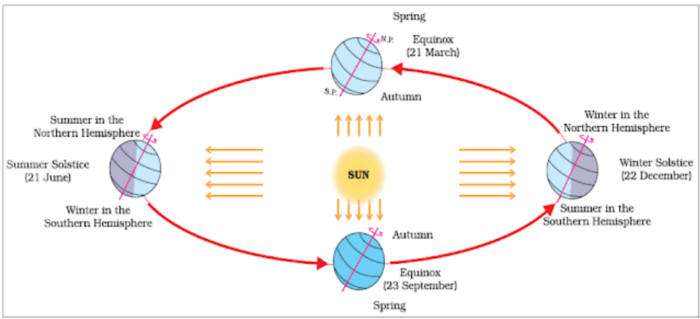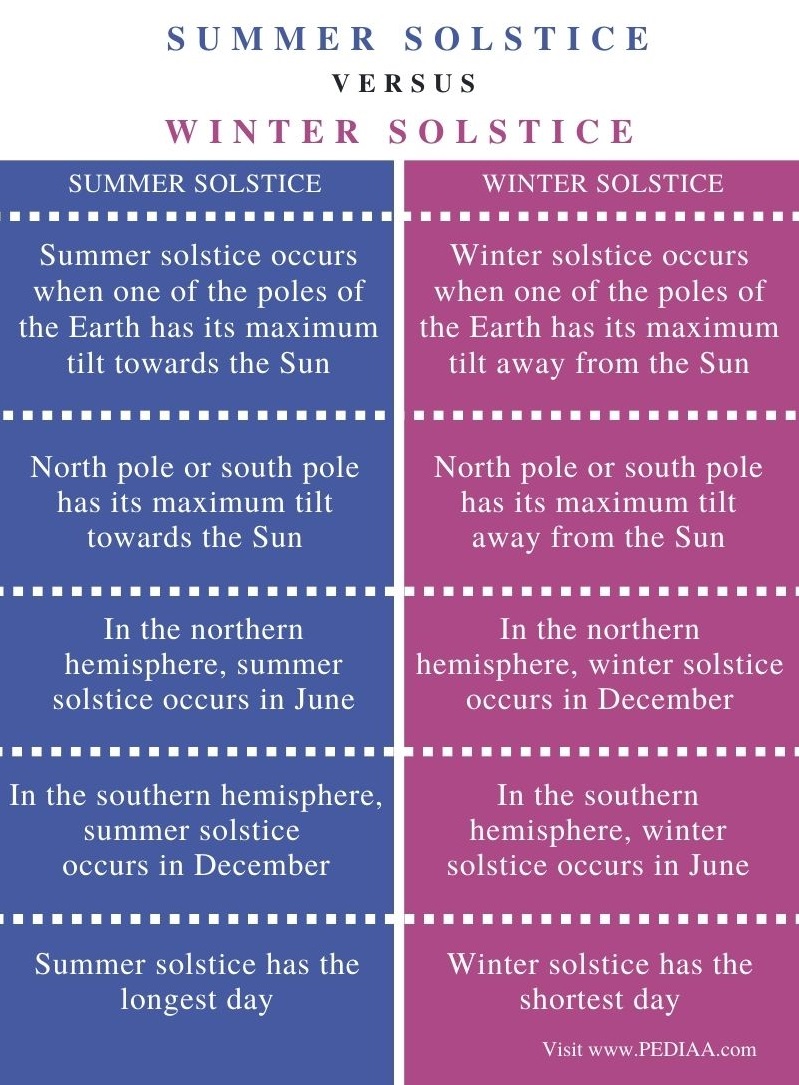Shortest day of the year marking the start of winter. Winter solstice occurs.

Difference Between Summer Solstice And Winter Solstice In A Tabular Format
Even though the day of the summer solstice has the greatest number of daylight hours it is.

. 10 rows Summer solstice occurs when North Pole is tilted closest to the Sun. 2 on a question Describe the difference between the summer and winter solstice. At the winter solstice the.
In the Northern Hemisphere the longest day and the shortest night occur on 21st June. Summer solstice June 20 or 21. Winter solstice is when the North Pole tilts away from the sun causing the least amount of daylight.
Along the arctic circle how would the sun appear during the summer solstice. The period when this tilt is towards the sun is called summer solstice and the day on which this tilt is maximum is June 21 in the northern hemisphere. While the solstices result in a change of the length of night and day the equinoxes do not.
And autumnal equinox september 22. Therefore on the day of the summer solstice the sun appears at its highest elevation with a noontime position that changes very little for several days before and after the summer solstice. Closer to the equator between both tropics the sun remains high in the sky and is never very low resulting in year round tropical humid weather with little seasonal changes.
The approximate date of these Solstices and equinoxes are winter solstice december22. The Solstices are the place where the inclination As the plane of equato View the full answer. During this time the northern hemisphere is tilted towards the sun resulting in increased sunlight and warmer temperatures.
The summer and winter solstices result in the longest and shortest day of the year respectively while the equinoxes result in an equal amount of daylight and darkness received all across the earth. Up to 10 cash back Purpose To describe the effect of seasonal variations on sleep patterns in a hot climate Arab region. Solstice refers to either of the two moments in the year when the Suns path is farthest north or.
Summer solstice is when the North Poles tilt is toward the sun the sun is greatest in the northern hemisphere. At this time in the Southern Hemisphere it occurs the shortest day and the longest night. During the winter solstice.
Summer solstice occurs around June 21 in the Northern Hemisphere the longest day of the year. An example of the effect can be seen in sunrise and sunset times around the summer and winter solstice - approximately 21st June and 21st December. Methods This is a cross-sectional study that included healthy Omani subjects of both genders between ages 18 and 59 years.
The equinox happens two times each year. The Winter Solstice is also reversed and occurs on either the 21 st or 22 nd of June when the day is shortest. Winter solstice December 21 or 22.
Vernal equinox march 21. In the Northern Hemisphere it is around 21st June. As Earth moves in its orbit the tilt of the North Pole changes which in turn brings changes in the seasons.
The Northern Hemisphere experiences the summer solstice when the Southern Hemisphere is experiencing the winter solstice and vice versa. In the Southern Hemisphere it is around 21st. Review questions chapter 6.
But which solstice happens on which day depends on the hemisphere you live in. Equinox vs Solstice. The Summer Solstice in the Southern Hemisphere on the other hand occurs on December 21 st or 22 nd and people experience the longest day below the Equator.
The main difference between summer and winter solstice is that summer solstice occurs when one of the poles of the Earth has its maximum tilt towards the Sun while winter solstice occurs when one of the poles of the Earth has its maximum tilt away from the Sun. The Solstices Summer Winter The summer solstice occurs at the moment the earths tilt toward from the sun is at a maximum. On Winter Solstice the polar North receives no energy from the Sun.
In the Northern Hemisphere the shortest day and the longest night occur on 22nd. Happens twice a year. Data for sleep pattern identification in summer and winter were collected from participants using an actigraphy.
Summer solstice June 22. During equinox rotation of the earth is perpendicular to the sun. Happens twice a year.
During the summer solstice north poles of the earth are directed towards the sun while in winter solstice north poles of the earth directly away from the sun. In the Northern Hemisphere it is around 22nd December. Why is Vernal Equinox important.
Autumnal equinoxabout September 23. The contrast between Winter. Solstice also happens two times in a year once in summer and other in winter.
This position of the earth is called summer solstice. Difference between Summer Solstice SS and Winter Solstice WS SS. Day and night of equal length marking the start of autumn.
The summer solstice marks the beginning of summer and is the longest day of the year just as the winter solstice marks the beginning of winter and is the shortest day of the year. Winter solstice is the shortest day of the year falls in December every year whereas Summer solstice is the longest day of the year falls in June every year. The least sunlight of the year winter solstice occurs during December 21 st or 22 nd.
The March equinox also called the vernal equinox marks the beginning of the spring season in the Northern Hemisphere and the autumn season in the Southern Hemisphere. During the Northern Hemispheres summer solsticewhich always falls around June 21the Southern Hemisphere gets its winter solstice. Occurs on March 20 vernal equinox and on September 22 autumnal equinox Occurs on June 21Summer Solstice and on Dec 22 Winter Solstice.
Answer 1 of 5. In the Southern Hemisphere it is around 22nd December. As we prepare to witness the first solar eclipse of the year on June 21 what we also await is the.
If there is a net annual heat loss at high lattudes and the net annual heat gain is at low latitudes why does the temperature difference between. In contrast the amount of incoming solar energy the Earth receives on June 21 Summer Solstice is 30 percent higher at the North Pole than at the Equator. Difference Between Winter Solstice and Summer Solstice Rotation of earth around its own axis which is tilted around 235 degrees to the perpendicular causes seasons on earth.
A solstice is when the sun appears as far north or south of the equator at possible. Longest day of the year marking the start of summer. The solstice occurs during the summer and the winter.

Summer And Winter Solstice Geography Arinjay Academy

What Is The Difference Between Summer And Winter Solstice Differbetween

What Is The Difference Between Summer And Winter Solstice Pediaa Com
0 Comments